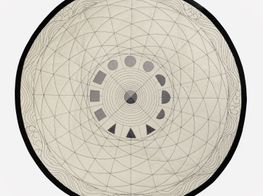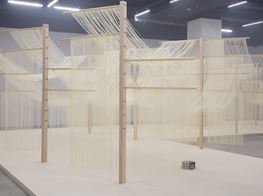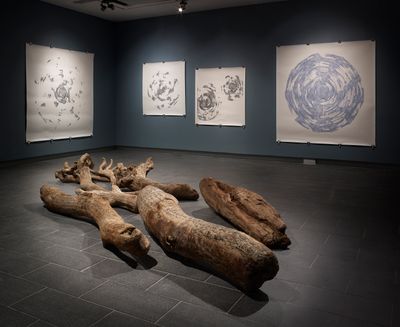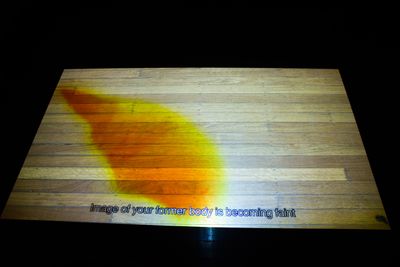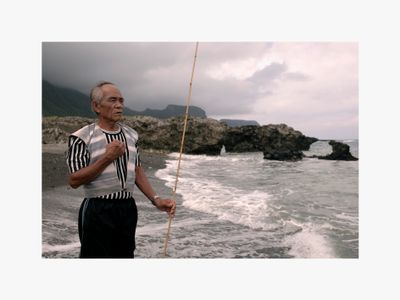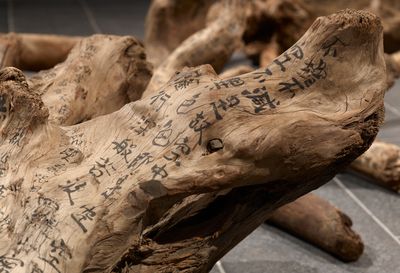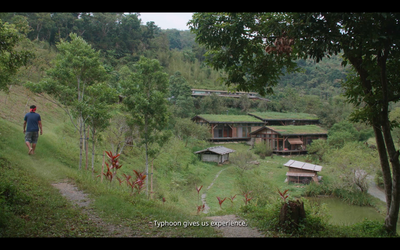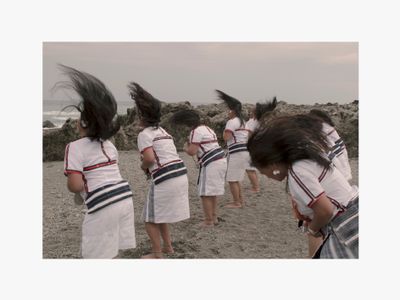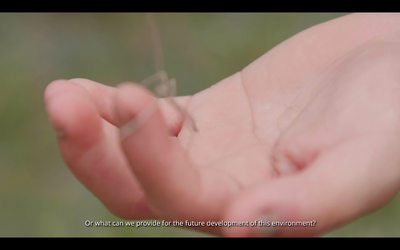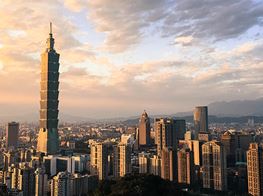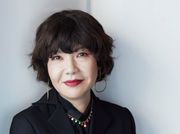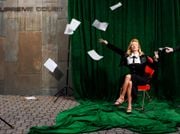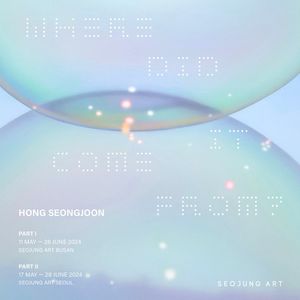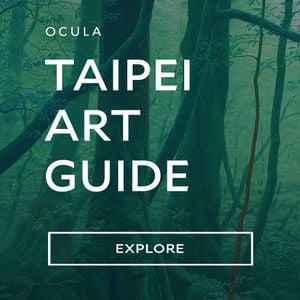Charwei Tsai
Charwei Tsai, Plane Tree Mantra (2014). Courtesy Natural History Museum, Paris. Photo: Bruno Jay.
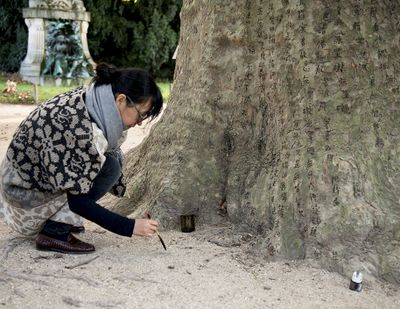
Charwei Tsai, Plane Tree Mantra (2014). Courtesy Natural History Museum, Paris. Photo: Bruno Jay.
Taiwanese artist Charwei Tsai's memorising and compulsive writing of the Heart Sutra—a Buddhist scripture that distills the wisdom of impermanence—is at the heart of her practice. Over the past ten years, Tsai has moved from writing to drawing, photography, and film—a selection of which is being presented at the Centre for Chinese Contemporary Art in Manchester (CFCCA) for the artist's first exhibition in the UK (Bulaubulau, 12 October 2018–20 January 2019).
Born in Taiwan in 1980, Tsai graduated in 2002 from the Rhode Island School of Design and worked as an assistant to Cai Guo-Qiang in New York. Tsai's early career involved writing the Heart Sutra on organic materials such as tofu and plants—a practice that was encouraged by Cai who later recommended the artist for an exhibition at the Fondation Cartier in Paris (J'en rêve, 2005). Over time, Tsai's practice transitioned to other media, deepening her exploration of the relationship between humans and nature.
Geographical, social, and spiritual motifs are recurrent throughout Tsai's works. In 2016, the artist worked with Tibetan filmmaker Tsering Tashi Gyalthang to produce a film based on the book Bardo Thodol, also known as the 'Tibetan Book of the Dead'. Originally produced for the 20th Biennale of Sydney: The future is already here—it's just not evenly distributed (18 March–5 June 2016), the work explores the transition of human consciousness between death and rebirth, and was projected onto the floor of Sydney's Mortuary Station—once a destination point for funeral trains carrying bodies of the deceased.
Also included in the exhibit was an installation of large incense coils carefully inscribed with the Heart Sutra, Spiral Incense – Hundred Syllable Mantra (2016). Tsai also worked with incense for her dual exhibition with Wu Chi-tsung at Edouard Malingue Gallery in 2014, Meeting Point. Comprised of four photographs and a video, the artist collaborated with Tsering Tashi Gyalthang to document the transition of incense to ashes.
Tsai frequently engages with the indigenous communities of her home country, Taiwan. The symbiotic relationship between sustainability, tradition, and ritual are explored through extensive research, as manifested in the video essay Lanyu—Three Stories (2012). Comprised of three short stories, the videos provide a portrait of the culture of the Tao Tribe who live on Lanyu—a small, mountainous island off the southern coast of Taiwan that controversially houses the nuclear waste of Taiwan's three nuclear reactors.
The artist discusses this work along with the rest of the material included in her solo exhibition at CFCCA, in this edited transcript of a public conversation that took place with Tiffany Leung in Manchester in October.
Writing, especially of the Heart Sutra, is an integral part of your practice. Having already learned the Buddhist scripture as a child, would you consider it a natural progression to have included it in your practice?
Buddhism is more a way of life than a religion to me. It is a study of the mind and the root cause of suffering. The Heart Sutra deconstructs the formation of our mind into five skandhas: body, feeling, perception, mental formation, and consciousness. The scripture articulates that everything that is compounded disintegrates and all phenomena are without inherent existence. This is the Buddhist concept of emptiness. From this perspective, the root cause of suffering is the false belief that all phenomena that we experience are somehow independent or permanent.
This not a mystical view on reality, it is in fact very logical. The difficult part is training the mind to recognise the transient nature of thoughts and emotions on an experiential level. It is a training that requires lifelong, continual practice. Writing the Heart Sutra is a way for me to appreciate and familiarise myself with the concepts of emptiness and impermanence. I memorised it as a child and my understanding of it will continue to evolve as I gain more life experience.
When you are engaged in writing the Heart Sutra during a performance like Plane Tree Mantra (2014), do you see it as a form of meditation? How does the presence of an audience affect the performance?
I view this performance as a kind of group meditation. The presence of the audience definitely makes a difference; I can feel their focus while observing the writing process and it helps me to concentrate more. In these situations, I can sometimes visualise each character from my heart through my arms to my hands, followed by a manifestation on paper in brush and ink. The process of making the work has always been the most important part of my practice, so I am always glad when people are interested in participating in this process.
When I performed the work at Southbank Centre, I had just received sad news of a friend who passed away in a car accident. I took the opportunity while writing to imagine the text as a support for him and his family through that difficult period.
Your solo show at CFCCA brings together a selection of old and new works. It would be interesting to hear about the transition of your thinking and process from earlier works like Driftwood (2011) and Lanyu—Three Stories (2012) to the new video commission Bulaubulau (2018).
Since the beginning of my practice, I have always used nature as a metaphor to express the concept of impermanence. Typhoons are one of the major natural disasters that we face every year in Taiwan. I happened to be visiting the east coast of Taitung after a huge Typhoon and there was a lot of driftwood that had washed ashore. My friend's father, who founded the village of Bulaubulau along with his young indigenous students, helped me collect some for my project. In Buddhist texts, we use the metaphor of travelling to the shore to represent the process of enlightenment. I used driftwood to imagine a rough life journey, from one shore to another. This project is more like an offering; it's quite different from the two videos that you mentioned, which are studies of two tribal communities.
My uncle's roommate and closest friend in college is a very respected singer in Taiwan. In my uncle's earlier life, he spent a lot of time with his indigenous friends and even dressed in their traditional clothes. He took classes to learn their language, sang their songs, and studied their traditions. He also joins protests for indigenous rights and supports their schools in remote areas. He even traced our family history and discovered that we have indigenous blood from my grandmother's side. I met most of the indigenous communities through my uncle. The nature of my relationship with these communities is more personal than professional.
I first visited the island of Lanyu as I was curious about the community's shamanistic practice of the 'hair dance'. It's a ritual dance in which women sway their hair up and down to create waves through their mindstreams to bring their men safely back from the sea. After spending time on the island, I came across some serious environmental and social issues that the community is facing regarding nuclear waste. I thought it was interesting how Taiwan is already such a small island, yet we are bullying an even smaller one. It's also interesting how the issues confronted on this small island of only about 4,000 occupants mirror the crises that we face globally. This experience marked a transition in my work where I started to engage more with social issues.
Bulaubulau is a very different project. It is a study on an experimental school that my friend and his family started for the younger generation in their village. The school aims to integrate traditional tribal knowledge and land ethics with modern and practical skills. Many of the children who attend this school are from families in very difficult situations. The school provides dormitories to house these students if their parents are not able to look after them. It also offers a rare and enormous opportunity for students to earn a high school diploma and be prepared to enter the competitive work environment in the city. This project expanded my understanding of sustainability on all levels—environmental, economic, as well as social, so I wanted to share it in the exhibition.
Your exhibition is part of CFCCA's 'Season for Change' programme (July–December 2018) that explores contemporary art as a means of raising awareness about environmental issues and imminent disasters caused by climate change. How do you see yourself and your works as relating to this wider conversation?
When I was invited by CFCCA to create an exhibition in relation to climate change and sustainability, I immediately thought of doing a project with the indigenous communities in Taiwan. Around the world, these communities contribute least to the issues of climate change, but as their livelihood is directly connected to the land, they suffer the most from its devastating effects. For this project, I wanted to go beyond blaming the government and to present some successful examples of combating environmental issues within these communities. Since these grassroots projects are initiated out of a necessity for survival, they tend to dig deeper into the root of the problem.
After returning to Taiwan from Manchester, I went to visit another tribe called Smangus. When Taiwan was under Japanese occupation from 1895 to 1945, a lot of our indigenous trees were felled and used to build temples in Japan. Smangus is located deep in the mountains in a remote region that was not reached by the Japanese. This tribe is known for their preservation of ancient giant cypress trees. An area for eco-tourism has been developed by the tribe to protect it from illegal logging. This is another example that I would like to present in the near future. The media tends to cover environmental issues that generate a lot of fear; I want to provide examples of people who are working hard to find alternative solutions on a grassroots level that we can all relate to.
Out of curiosity, what would your ideal studio or working space be like?
My ideal studio space is my studio in Taipei. Before this, I worked between my kitchen table and exhibition sites for more than a decade. The studio that I have now has changed my life and work completely. Since practicing as an artist, I have travelled everywhere that I am invited. I rarely stay in one city without travelling for more than a few weeks at a time. I fully enjoyed this lifestyle until I reached my mid-thirties. Now I would like to have a more stable physical environment in order to spend more time on my work. My studio in Taipei helps to ground me as an artist and as a person. Now I try to minimise my work trips so that I can come back and slip into a productive work mode.
Besides working on my own projects at my studio, I also host many activities. These include a meditation group that practices at the studio three nights a week. Various art communities occasionally conduct workshops or film screenings there as well. It is like a sanctuary for me to reflect, produce, and exchange. –[O]

